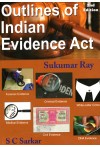- Author(s): Sukumar Ray
- Publisher: S C Sarkar & Sons Private LTD
- Edition: 2 Ed 2018
- Approx. Pages 668 + Contents
- Format Hardbound
- Approx. Product Size 24 x 16 cms
- Delivery Time 3-5 working days (within Kerala & South India) (Others 7-9 days)
...................................................................................................................................................................................................................................
Description
• The instant work offers an integrated, unified, consolidated and comprehensive view
of the Indian Evidence Act in a highly decipherable design and format;
• This work bears the stamp of subtle and shrewd, elusive and in depth analysis of different
aspects of law of evidence;
• It covers the entire range of law and procedure;
• Written in simple and practical language;
• Practical problems tackled;
• It lays stress on the modern trend in the analysis of'electronic evidence;
• Evidentiary value of modern scientific tests have also been discussed. Reasons for enactment of
important sections are discussed and defined with all clarity;
• Living examples are placed in appropriate places to understand the law;
• Differences between sections and important concepts in tabular form are an unique
feature of this book;
• Important judgments of the Privy Council, Supreme Court and different High Courts are
discussed wherever necessary and for the sake of elucidating the principles of law;
• This work is an amazing and astounding merging and mingling of evidence in theory and practice;
• Proposed amendment of the Indian Evidence Act adds another feather to this book;
• It is a treasure-house and treasure-hunt of useful and invaluable information; and
• This book is not only a guide but also a lexicon not only for the lawyers but also for the
academicians and members of the legal fraternity.
......................................................................................................................................................................................................................................
Contents
Introduction
law of Evidence during ancient period
Evidence of witness not cross-examined can be taken into consideration by the court
Examination of same person as prosecution witness as well as defence witness
Examination of investigating officer
General rules regarding appreciation of evidence - oral and documentary
PART I ; RELEVANCY OF FACTS
Chapter 1 : Preliminary
Chapter 2 : Of the Relevancy of Facts
PART II : ON PROOF
Chapter 3 : Facts which need not be provided
Chapter 4 : Of Oral Evidence
Chapter 5 : Of Documentary Evidence
Chapter 6 : Of the Exclusion of Oral by documentary Evidence
PART III : PRODUCTION AND EFFECT OF EVIDENCE
Chapter 7 : Of the Burden of Proof
Chapter 8 : Estoppel
Chapter 9 : Of Witnesses
Chapter 10 : Of the Examination of Witnesses
Chapter 11 : Of Improper Admission and Rejection of Evidence
Chapter 12 : Modern Investigative Tool and their Evidentiary Value
Chapter 13 : Proposed Amendment of Indian Evidence Act, 1872
Chapter 14 : Electronic Evidence and Mode of Proof
Subject Index
......................................................................................................................................................................................................................................
Author Details
Sukumar Ray, LLM (Cal0, West Bengal Judicial Service
Author of Outlines of Indian Penal Code; Outlines of Criminal Procedure Code; Textbook on Code of Civil Procedure; Outlines of Transfer of Property Act; Legal Services Authorities Act; Indian Partnership Act; ADR and Gram Nyayalayas Act; Sexual Violence against Women with Special Reference to Rape; Text book on Hindu Law and Administrative Law; Revising editor of b. B. Mitra's Indian succession Act (15th ed); A. N. Saha's Criminal Reference (7th Ed); Joint Revising editor of Ganguly's Civil Court Practice and Procedure (14th ed) and Ganguly's Criminal Court Practice and Procedure (11th ed).
......................................................................................................................................................................................................................................

